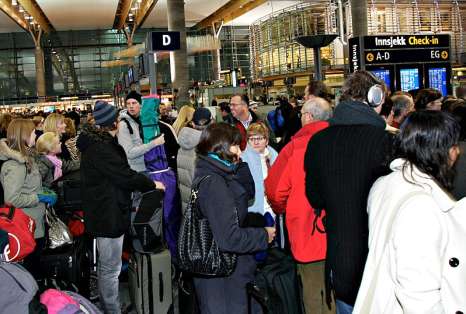 Two days ago, Norway’s major airport, Oslo Gardermoen (OSL) practically shut down due to weather conditions, so-called “freezing fog”. The usual rate of 32 take-offs per hour was reduced to 10 (at the best) and tens of thousands of Christmas travelers were stranded for up to more than 24 hours on what is probably THE busiest day of the year. What acerbated things was how the airlines dealt with the situation: No information to waiting passengers, no food coupons or refreshments, endless lines in front of ticket counters…
Two days ago, Norway’s major airport, Oslo Gardermoen (OSL) practically shut down due to weather conditions, so-called “freezing fog”. The usual rate of 32 take-offs per hour was reduced to 10 (at the best) and tens of thousands of Christmas travelers were stranded for up to more than 24 hours on what is probably THE busiest day of the year. What acerbated things was how the airlines dealt with the situation: No information to waiting passengers, no food coupons or refreshments, endless lines in front of ticket counters…
Who’s paying the price?
I know, the airlines may not be required to give you food coupons or refreshments for no reason, and many stick to the legal requirements for fear of overrunning costs, but they seem to forget the golden rule in business: If you take care of your customers, your customers will take care of you (your bottom line), and you cannot build customer loyalty with negligent service, and it is during crises like this a airline can really show how service-minded it actually is. Especially in the case of SAS, which recently launched a massive ad campaign around the theme “we are re-launching service”…well, so much for the ad campaign…
The season…to be merry?
 The airline industry is a highly competitive market and even established airlines like SAS have been forced to give in low-cost carriers and reduce their own prices. But slashing ticket prices often causes slashing service too, in order to keep expenses down. However, the long-term costs of loosing passenger loyalty compared to the short-term costs of dealing with an emergency cannot be underestimated. An airline like SAS may be in a monopoly situation at many airports in Norway, but it doesn’t mean that you don’t have to care, since your passengers have no choice anyway. Not only is customer loyalty important, customer attitude towards you should also matter, and the only way to achieve a strong brand name is through customer trust. And much of customer trust comes from exceeding customer expectations.
The airline industry is a highly competitive market and even established airlines like SAS have been forced to give in low-cost carriers and reduce their own prices. But slashing ticket prices often causes slashing service too, in order to keep expenses down. However, the long-term costs of loosing passenger loyalty compared to the short-term costs of dealing with an emergency cannot be underestimated. An airline like SAS may be in a monopoly situation at many airports in Norway, but it doesn’t mean that you don’t have to care, since your passengers have no choice anyway. Not only is customer loyalty important, customer attitude towards you should also matter, and the only way to achieve a strong brand name is through customer trust. And much of customer trust comes from exceeding customer expectations.
In terms of supply chain management in times of crises this means that you need to be able to handle the situation better than your customers expect you to handle it. Think ahead, be prepared, and most of all, be prepared to go a long way to satisfy your customers, even if your terms and conditions do not require you too. Now that may not make your supply chain resilient per se, but it will definitely be a major contribution to making your brand name and reputation resilient.
Merry Christmas!
Links
- aftenposten.no: Chaos continues at Gardermoen
- osl.no: Oslo airport official website
Related
- husdal.com: Airports – vital to supply chains?












